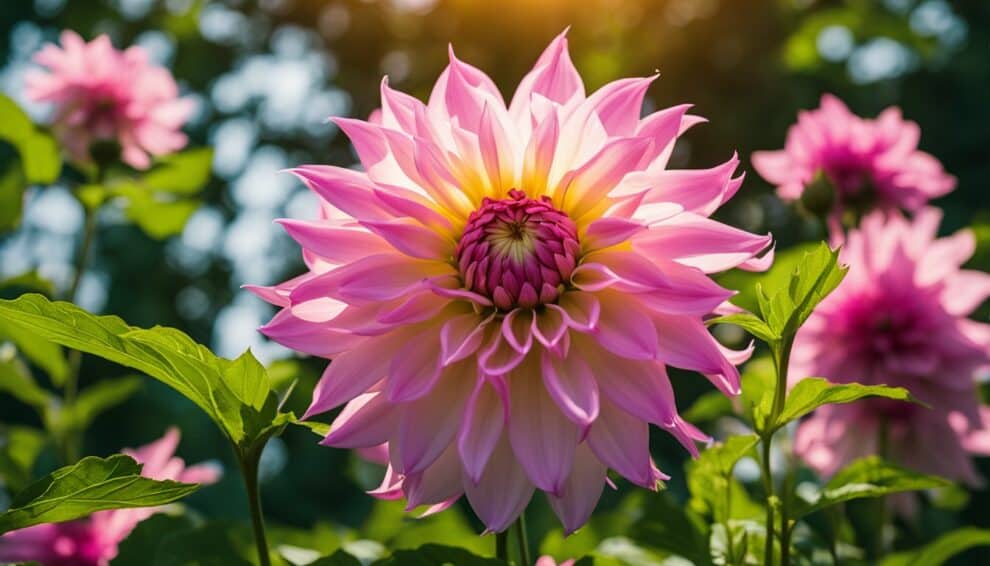Dahlia Imperialis, also known as the Tree Dahlia, is a stunning flowering plant that can grow up to 20 feet tall.
Native to the mountainous regions of southern Mexico and Guatemala, these towering beauties have become increasingly popular among gardeners around the world.
However, due to their size and unique growing requirements, caring for Tree Dahlias can be a challenge.

In this article, we will explore the key aspects of Dahlia Imperialis care, including planting, watering, fertilizing, pruning, and pest control.
Whether you are a seasoned gardener or a beginner, these tips and tricks will help you cultivate healthy and vibrant Tree Dahlias in your own backyard.
So, let’s get started and learn how to care for these magnificent plants!
Understanding Dahlia Imperialis
Botanical Profile
Dahlia Imperialis, also known as the Tree Dahlia, is a perennial plant belonging to the Asteraceae family.
It is native to the highlands of Mexico and Central America and is known for its towering height, which can reach up to 20 feet.
The plant produces large, showy flowers that bloom in shades of pink, purple, and white.
The leaves of Dahlia Imperialis are dark green and deeply lobed, with a velvety texture.
The stems are thick and sturdy, with a woody texture that allows the plant to support its impressive height.
Growth Habits
Dahlia Imperialis is a fast-growing plant that requires ample space and sunlight to thrive.
It prefers well-draining soil that is rich in organic matter, and regular watering during the growing season.
The plant is hardy to USDA zones 8-10 and can tolerate temperatures as low as 20°F.
Dahlia Imperialis is propagated by division or stem cuttings, and should be planted in the spring after the danger of frost has passed.
The plant can be grown as a specimen plant or as part of a mixed border, and is an excellent choice for adding height and drama to the garden.
Historical Significance
Dahlia Imperialis has a long history of cultivation, dating back to the Aztecs who used the plant for medicinal and ornamental purposes.
The plant was introduced to Europe in the 18th century and quickly became popular among gardeners for its impressive height and showy blooms.
Today, Dahlia Imperialis is a popular garden plant around the world, prized for its beauty and easy care.
With the right growing conditions and care, this towering beauty can be a stunning addition to any garden.
Cultivation Techniques

Planting Guidelines
When planting Dahlia Imperialis, it is important to choose a location that receives full sun or partial shade.
The soil should be well-draining and rich in organic matter. Before planting, the soil should be prepared by adding compost or aged manure.
The planting hole should be dug to a depth of at least 12 inches and should be wide enough to accommodate the root ball of the plant.
Once planted, the soil should be watered thoroughly.
Soil Requirements
Dahlia Imperialis prefers a soil that is rich in organic matter and well-draining. The soil pH should be between 6.0 and 7.5.
If the soil is too acidic, lime can be added to increase the pH. If the soil is too alkaline, sulfur can be added to decrease the pH.
Adding compost or aged manure to the soil will help to improve soil structure and fertility.
Light and Temperature Needs
Dahlia Imperialis requires full sun or partial shade to thrive.
It prefers a temperature range of 60 to 70 degrees Fahrenheit during the day and 50 to 60 degrees Fahrenheit at night.
In areas with hot summers, it may be necessary to provide some shade during the hottest part of the day.
In colder climates, the plant may need to be protected from frost.
Overall, Dahlia Imperialis is a stunning addition to any garden, but it does require some specific care and attention.
By following these cultivation techniques, gardeners can ensure that their tree dahlias will thrive and provide years of beauty.
Maintenance and Care

Watering Practices
Tree dahlias enjoy moist soil, but they don’t want to be waterlogged.
Watering should be done frequently during hot, dry weather to keep the soil moist but not soaked.
The amount of water required varies depending on the climate, soil type, and plant size.
A general rule of thumb is to water the plant thoroughly once a week, but adjust the frequency and amount based on the plant’s needs.
Fertilization and Nutrition
Tree dahlias are heavy feeders and require regular fertilization to thrive.
A balanced, slow-release fertilizer can be applied in the spring and again in mid-summer to provide the necessary nutrients.
Organic fertilizers, such as compost or aged manure, can also be used.
Be sure to follow the package instructions or use the appropriate amount of organic matter for the size of the plant.
Pruning and Support
Tree dahlias can grow up to 20 feet tall, so they need support to prevent them from falling over.
Staking or tying the main stem to a sturdy support, such as a fence or trellis, can help keep the plant upright.
Pruning is also important to maintain the plant’s shape and size.
Remove any dead or damaged branches and cut back the top of the plant in the spring to encourage bushier growth.
Avoid pruning in the fall or winter, as this can encourage new growth that may be damaged by frost.
By following these simple maintenance and care practices, your tree dahlias will thrive and provide you with towering beauty in your garden.
Pest and Disease Management

Tree dahlias are generally hardy and resistant to most pests and diseases. However, they can still be affected by a few common issues.
Here are some tips to help you manage any problems that may arise:
Pests
- Aphids: These small, pear-shaped insects can be found on the undersides of leaves and can cause distorted growth and yellowing.
To control aphids, spray the affected plant with a strong jet of water or use insecticidal soap.
- Slugs and snails: These slimy creatures can chew on leaves and damage the plant.
To control slugs and snails, handpick them or use slug bait.
- Spider mites: These tiny pests can cause yellowing and stippling of leaves.
To control spider mites, spray the affected plant with water or use insecticidal soap.
Diseases
- Powdery mildew: This fungal disease appears as a white powdery coating on leaves and stems.
To prevent powdery mildew, ensure good air circulation around the plant and avoid overhead watering.
If the disease does occur, remove affected leaves and treat the plant with a fungicide.
- Root rot: This disease is caused by overwatering and poor drainage.
To prevent root rot, ensure the plant is in well-draining soil and water only when the top inch of soil is dry.
If root rot does occur, remove affected roots and repot the plant in fresh soil.
By following these tips, you can keep your tree dahlias healthy and beautiful all season long.
Frequently Asked Questions

What are the ideal growing conditions for Dahlia imperialis?
Dahlia imperialis thrives in a warm, sunny location with well-draining soil. They prefer a slightly acidic soil pH of 6.0 to 6.5.
These plants require regular watering, especially during the growing season.
They also benefit from regular fertilization with a balanced, slow-release fertilizer.
How often should I water my tree dahlia?
Tree dahlias require regular watering, especially during the growing season. Water deeply once or twice a week, depending on the weather and soil conditions.
Be sure to water the soil around the plant, not the foliage, to avoid encouraging fungal diseases.
What is the best way to propagate Dahlia imperialis?
The best way to propagate Dahlia imperialis is by division in the spring.
Dig up the plant and carefully separate the tubers, making sure each section has at least one growing point.
Plant the tubers in well-draining soil and water thoroughly. Alternatively, you can propagate tree dahlias from stem cuttings taken in the summer.
Are there any common pests or diseases that affect tree dahlias, and how can I prevent them?
Tree dahlias are relatively pest and disease-resistant, but they may be susceptible to aphids, spider mites, and powdery mildew.
Regularly inspect your plants for signs of infestation, and treat them with insecticidal soap or neem oil if necessary.
To prevent fungal diseases, avoid overhead watering, and provide good air circulation around the plants.
Can tree dahlias survive in colder climates, and if so, how can I protect them from frost?
Tree dahlias are native to the high elevations of Mexico and Central America and can tolerate temperatures down to 20°F (-6°C).
However, they may suffer damage from frost, especially if the soil is wet.
To protect your plants, cover them with a layer of mulch or straw in the fall, and wrap them with burlap or frost cloth if necessary.
What is the maximum height tree dahlias can reach, and how long does it take for them to grow that tall?
Tree dahlias can reach heights of 20 feet (6 meters) or more in ideal growing conditions.
However, they typically grow to heights of 10 to 15 feet (3 to 4.5 meters) in cultivation.
It can take several years for tree dahlias to reach their full height, depending on soil, water, and climate conditions.














